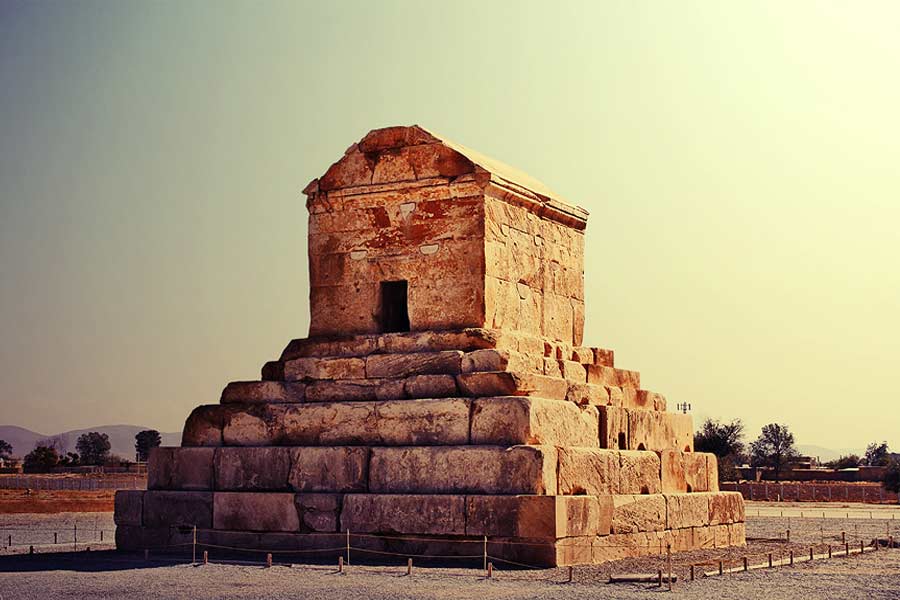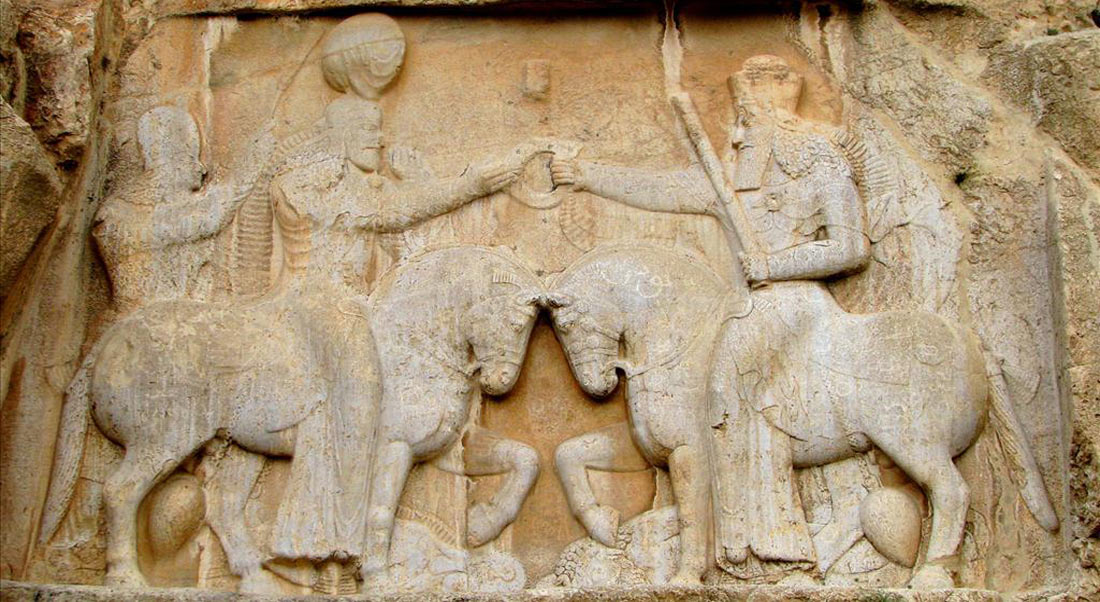Overview
Pasargadae , Persepolis and Naghsh-e Rostam (Necropolis ) and Naghsh-e Rajab Tour
Pasargadae
Pasargadae was the first dynastic capital of the Achaemenid Empire, founded by Cyrus II the Great, in Pars, the homeland of the Persians, in the 6th century BC. Its palaces, gardens and the mausoleum of Cyrus is an outstanding example of the first phase of royal Achaemenid art and architecture and exceptional testimonies of Persian civilization. Particularly noteworthy vestiges in the 160-ha site include the Mausoleum of Cyrus II; Tall-e Takht, a fortified terrace; and a royal ensemble of gatehouse, audience hall, residential palace, and gardens. Pasargadae was the capital of the first great multicultural empire in Western Asia. Spanning the Eastern Mediterranean and Egypt to the Hindus River, it is considered to be the first empire that respected the cultural diversity of its different peoples. This was reflected in Achaemenid architecture, a synthetic representation of different. The Pasargadae was designated a UNESCO WORLD HERITAGE SITE

Persepolis
Persepolis, Old Persian Parsa, the ancient capital of the kings of the Achaemenian dynasty of Iran (Persia), located about 30 miles (50 km) northeast of Shiraz in the Fars region of southwestern Iran. In 1979 the Persepolis was designated a UNESCO WORLD HERITAGE SITE . Though archaeologists have discovered evidence of prehistoric settlement, inscriptions indicate that construction of the Persepolis began under Darius I, who, as a member of a new branch of the royal house made Persepolis the capital of Persia proper, replacing Pasargadae, the burial place of Cyrus II (the Great). Built-in a remote and mountainous region, Persepolis was an inconvenient royal residence, visited mainly in the spring. The effective administration of the Achaemenian realms was carried on from the imperial cities of Susa, Babylon, and Ecbatana. This accounts for the Greeks being unacquainted with Persepolis until Alexander the Great’s invasion of Asia. In 330 BCE, during the reign of Darius III, Alexander plundered the city and burned the palace of Xerxes, whose brutal campaign to invade Greece more than a century before had led, eventually, to Alexander’s conquest of the Persian empire. In 316 BCE Persepolis was still the capital of Persis as a province of the Macedonian empire. The city gradually declined under the Seleucid kingdom and after, its ruins attesting its ancient glory

Naghsh- e Rostam (Necropolis)
Naqsh-e Rustam is one of the most spectacular and awe-inspiring ancient sites of the Achaemenid Empire, consisting of the colossal tombs of Persian kings dating back to the first millennium BC. It stands as a lasting memory of a once-powerful empire that ruled over a significant portion of the ancient world. Naqsh-e Rustam has located approximately 5 km (3 miles) to the northwest of Persepolis, the capital of the former Achaemenid (Persian) Empire in the present day in Iran. Engraved on the facade of a mountain range considered sacred in the Elamite periods are the rock-cut tombs of Achaemenid rulers and their families dating to the 4th and 5th centuries BC, as well as richly decorated reliefs carved by the Sasanians in the 3rd century AD. In addition to being a royal necropolis, Naqsh-e Rustam became a major ceremonial center for the Sasanians until the 7th century AD. The Naqsh-e Rustam site was already in use prior to the arrival of the Achaemenids, as evidenced in one pre-Achaemenid (possibly Elamite) relief and a number of old graves. Although this relief has been carved over by a Sasanian relief, a portrait of a man with a forward-pointing hat and a long dress-like garment (clothing not typical of the Achaemenids and Sasanians) can still be discerned on the extreme right of the later relief. According to some sources, it was this figure that locals associated with the mythical hero of the Shahnameh (Kings Letter ) writings in the “book of the kings”, named Rustam, hence the name of the site. Most of the reliefs, however, date to the beginning of the Sasanian period. In the 3rd century AD, the Sasanians, a vassal of the Parthian Empire that succeeded in overthrowing its master, were a new power that rose in the East. In order to legitimize their rule, the Sasanians sought to associate themselves with the Achaemenid (Persian) Empire and regarded themselves as to its direct successors. One of the things they did to achieve this goal was to carve reliefs at Naqsh-e Rustam

Naghsh-e Rajab
Naghsh-e Rajab is one of the most beautiful ancient rock carvings in Iran which is within reach of Persepolis 3kms away in Shiraz. Once you are there, you will see the massive carvings to the right of the Royal road ( Shahi Road), the main road built here 25 centuries ago to connect Susa in Persia to Sardis in Lydia. Naghsh-e Rajab has been carved in the northern slope of Mount Rahmat and depicts historical scenes from the coronation of Ardeshir I (224-239 BCE), the figure of Shapur I and his coronation (239-270 BCE). Many carvings have remained here from the Sassanid Period. As the Sassanid (Second Persian Empire) were from the Achaemenid (First Persian Empire) bloodline, the stone carvings from their time are also concentrated in Pars Province in proximity to Persepolis. Ardeshir I established the Sassanid Dynasty and Empire and the carving of his coronation are one of the oldest carvings in Naghsh-e Rajab of Fars. This depicts Ardeshir I holding the crown of power in his right hand, which he has received from Ahura Mazda (the Supreme being in Zoroastrianism), while he is wearing a majestic crown on his head and pointing his index finger to the sky as a sign of respect. In the second carving, Shapur I is seen on his horse at his coronation ceremony. This is a masterpiece from the Sassanid Period and an amazing harmony and balance can be seen in the work. Sitting on his horse, Shapur takes the crown of power from Ahura Mazda while he is holding the sword in his left hand. The details of his face and hand have faded with the passage of time. The third carving also depicts Shapur I on his horse followed by nine of his courtiers. Last but not least, the fourth carving shows the Magi of all magis, Kartir, one of the most influential religious figures of the Sassanid Period under Shapur I, Bahram I, and Bahram II. He is holding his index finger upward as a sign of respect for the congregation of the Empire which is depicted separately on a carving behind him

To request a tour to Pasargadae , Persepolis , Naghsh-e Rostam ( Necropolis ) and Naghsh-e Rajab , please mention the following items in your email
1. Dates of your tour
2. Number of travelers
3. Preference of spoken language by the travel guide Kindly note that to book a travel guide in advance, we would be thankful if you send us your query at least one day prior to your travel to these amazing sites.
Please also note that refunds condition will be announced upon your request. Our email address is Info@inboundpersia.com